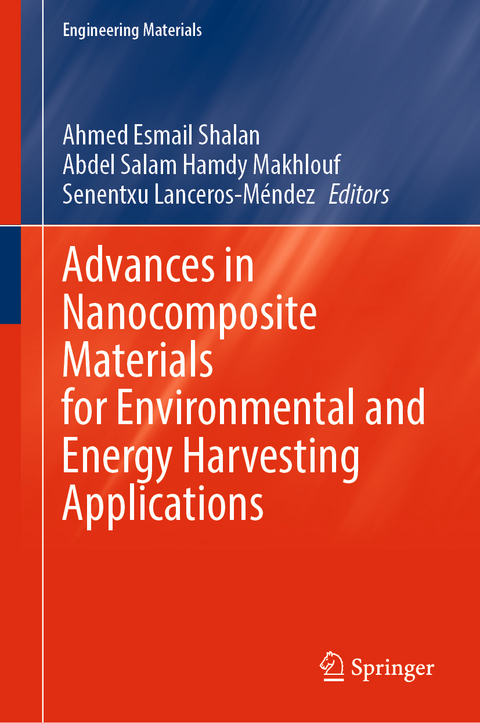
Advances in Nanocomposite Materials for Environmental and Energy Harvesting Applications
Springer International Publishing (Verlag)
978-3-030-94318-9 (ISBN)
lt;p> Ahmed Esmail Shalan is Juan de la Cierva Fellow at BCMaterials, Basque Center for Materials, Applications, and Nanostructures, Leioa, Spain. He obtained his BSc (2008) and MSc (2012) in Materials Science from Ain Shams University, Egypt and his PhD (2017) from Hokkaido University, Japan. He is a Researcher at Central Metallurgical Research & Development Institute (CMRDI), Egypt (now, on leave). He obtained several awards and prizes like attending 69th Lindau Nobel Laureate Meeting 2019, Egyptian Academy Prize (2018, 2020), Japanese government PhD scholarship (MEXT, 2013-2017), and fellowships like DAAD fellowship (i-MEET-FAU), Germany (2013). His work reflects his interest in physical chemistry and materials science for energy, environmental and optoelectronic devices applications.
Professor Makhlouf is the Vice President of Advanced Material Research, Stanley Black & Decker, Inc., USA. Before joining Stanley Black & Decker, he was the President of EMC3 - USA, VP of IM2C - USA, Full Professor of Materials Science at Central Metallurgical Research and Development Institute - Egypt, and Full Professor of Manufacturing and Industrial Engineering at the University of Texas - USA. Makhlouf has been included in Stanford University's List of World's Top 2% of Scientists, USA, 2020 & 2021. He is also the recipient of numerous national and international prizes and awards including the Humboldt Research Award for Experienced Scientists, at Max Planck Institute, Germany; Fulbright Scholar, NSF, Dept. of Energy Fellowships, USA. Shoman Award in Engineering Science; and the State Prize of Egypt in Advanced Science and Technology, and more.
Senentxu Lanceros-MéndezPart I Fundamental of nanocomposite materials synthesis and production.- 1: Nanocomposites materials and their applications: current and future trends.- 2: Versatile production of new multi-functional and composite nanomaterials by means of cold plasma - liquid interactions.- 3: Carbon Nanostructure Based Composites for Environmental and Energy Applications.- 4: A novel synthesis of gold nanoparticles-layered double hydroxides nanocomposites through in-situ reductive adsorption of gold(III) ion on organic acid-functionalized Mg/Al layered double hydroxides.- 5: Graphene and its nanocomposites derivatives: synthesis, properties, and their applications in water treatment, gas sensor, and solar cell fields.- 6: Bionanocomposites and their applications in energy Harvesting and deletion of environmental pollutions.- 7: A comparative study of cellulose nanocomposite derived from algae and bacteria and its applications.- Part II Advances in nanocomposite materials for environmental applications.- 1: Polymeric nanocomposite membranes for water remediation: from classic approaches to 3D printing.- 2: Biodegradable polymeric nanocomposites for wastewater treatment.- 3: Functionality-structure relationship into functional polymeric nanocomposite membranes for removal and monitoring of pollutants in fluid phases.- 4: Polymer-based nanocomposites for removal of pollutants from different environment using catalytic degradation.- 5: Role of Graphene oxide based Nanocomposites in Arsenic purification from Ground Water.- 6: Green Nanocomposites: Magical Solution for Environmental Pollution Problems.- 7: Recent Developments in Wastewater Treatment using Polymer/Clay Nanocomposites.- 8: Applications of nanocomposites in environmental remediation.- 9: Removal of radioactive waste from water using polymer nanocomposites.- Part III Advances in nanocomposite materials for energy harvesting applications.- 1: Mixed ionic-electronic conductors based on polymer composites.- 2: Nanocomposites for energy storage applications.- 3: Metal Sulfide Nanocomposites for Energy Harvesting Applications.- 4: Advanced Neutron and Synchrotron Characterization Techniques for Nanocomposite Perovskite Materials toward Solar Cells Applications.- 5: Development of Hierarchical nanostructures for Energy Storage.- 6: Polymer Nanocomposites for Energy Storage Applications.- 7: Incorporation of Nanocomposite Thin Films as effective electrodes for Photovoltaic Devices Applications.- 8: Recent advances of TiO2 nanocomposites for photocatalytic degradation of water contaminants and rechargeable Sodium ion batteries.- 9: Major trends and mechanistic insights for the development of TiO2-based nanocomposites for visible-light-driven photocatalytic hydrogen production.- 10: Polymer/Carbon nanocomposites: synthesis, properties and application in solar energy.- 11: Graphene based nanocomposites: Synthesis, characterization and energy harvesting applications.- 12: Design of new High Energy Near field Nanophotonic materials for far Field applications.- 13: Supramolecular Structures of Organic Molecules-Single Walled Carbon Nanotube Nanocomposites.- 14: Structure and Properties Manipulations of Graphene: towards Developing High Sensitivity Optical and Electrical Sensors.- 15: Bulk and Nanocomposite Thermoelectrics: Synthesis, Properties, and applications.- 16: Nanodiamond/conducting polymer nanocomposites for Supercapacitor applications.- 17: Supercapacitors: current trends and future opportunities
| Erscheinungsdatum | 06.03.2022 |
|---|---|
| Reihe/Serie | Engineering Materials |
| Zusatzinfo | XIX, 1089 p. 412 illus., 347 illus. in color. |
| Verlagsort | Cham |
| Sprache | englisch |
| Maße | 155 x 235 mm |
| Gewicht | 1718 g |
| Themenwelt | Naturwissenschaften ► Chemie ► Technische Chemie |
| Technik ► Maschinenbau | |
| Schlagworte | Energy Harvesting Applications • Environmental Applications • Environmental Pollution • Nanocomposite Materials • nanomaterials applications • Titania nanocomposites |
| ISBN-10 | 3-030-94318-6 / 3030943186 |
| ISBN-13 | 978-3-030-94318-9 / 9783030943189 |
| Zustand | Neuware |
| Haben Sie eine Frage zum Produkt? |
aus dem Bereich


